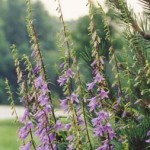Years ago my dear sister shared a plant with me that she uprooted her garden. “I don’t know what it is but it’s really pretty when the purple flowers bloom along the stalk”. So I planted the specimen in my garden, anxious to have a variety of blooming plants for curb appeal. BIG mistake!

Photo of non-native Creeping or European Bellflower by Elizabeth J. CzarapataTo this day I am still finding seedlings of Creeping/European bellflower (Campanula rapunculoides) popping up randomly far from the original planting site. This non-native bellflower can be distinguished by blossoms that occur along only one side of the flowering stalk. Click on the scientific name above for a link to view detailed facts and photos on the WI DNR website.
Words of caution to garden by, be suspicious of accepting any plants offered for free unless you are 100% certain that you won’t cause the next non-native invasive plant to enter and infest our natural areas. Well-meaning folks are more than happy to share plants that are growing crazy out of control and this should be your first inking of a potential problem. Do some investigating before planting and take if from me, if you Don’t Know – Don’t Plant!
I appreciated receiving and watching the link that follows. It is a short 3.5 minute video from the NY area sharing how burning bush (aka winged euonymus) may have innocently escaped cultivation and invaded native woodland habitats. Buckthorn, honeysuckle, barberry and many other non-native invasive plants have also infested natural areas across the country in a similar manner.
https://www.youtube.com/watch?
Help nature and plant only native, local origin plants on your property.


